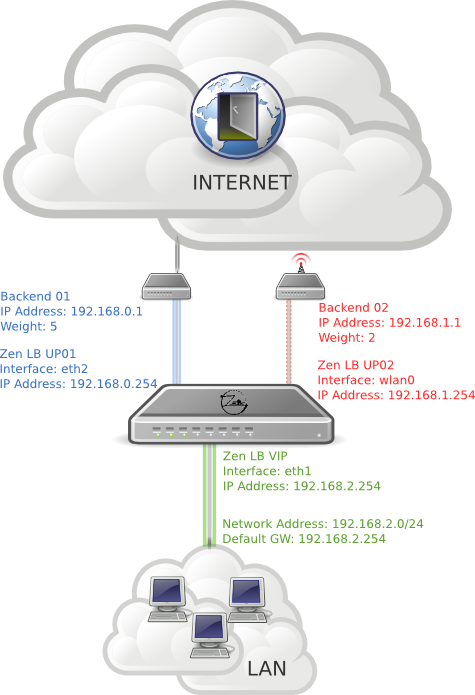DATALINK EDIT GLOBAL PARAMETERS
The DATALINK farm profile allows to create a routes based farm where the backends are uplink routers or gateways. This kind of farm profile is ready to share several uplink WAN router accesses using the load balancer as an uplink channel multiplexor (1 input and several router line outputs). Therefore, the DATALINK farms could be used as high available communication links and additionally could be used as bandwidth increase joining the amount of bandwidth between the routers backends links.

The specific options to be able to configure a DATALINK farm profile is detailed in the current section. In general, the farm will be restarted automatically with every change in a specific option in this farm profile.

The current specific datalink farms parameter is described below.
Load Balance Algorithm. This field specifies the load balancing algorithm to be used in order to determine the backend router. By default, weight algorithm will be the default selected algorithm.
Weight: connection linear dispatching by weight. Balance connections depending on the weight value, you have to edit this value for each real server. The requests are delivered through an algorithm to calculate the load of every server using the actual connections to them, and then to apply a linear weight assignation.
Priority: connections always to the most prior available. Balance all connections to the same highest priority server. If the first server is down, the connections will switch to the next prioritiest server. With this algorithm you can build an active-pasive cluster service with the real servers.
In order to get more specific information regarding this kind of farms, please refer to the official ZenLB documentation named “Quick Start Guide for uplinks load balancing with Zen Load Balancer”.
DATALINK EDIT REAL SERVERS CONFIGURATIONS
With a DATALINK farm profile you’ll be able to configure the following real servers properties:
Weight. It’s the weight value for the current real server which is only useful if the Weight Algorithm is enabled. More weight value indicates more connections delivered to the current backend. By default a weight value of 1 will be set.
Priority. It’s the priority value for the current real server which is only useful if the Priority Algorithm is enabled. The priority value accepted is between 1 and 9, less value indicates more priority to the current real server. By default a priority value of 1 will be set.

With the  Save Real Server button you’ll apply the new configuration, or you’ll be able to
Save Real Server button you’ll apply the new configuration, or you’ll be able to  cancel the process.
cancel the process.

Once the real server configuration is entered, you’ll be able to edit the config throught the  Edit button or delete the configuration with the
Edit button or delete the configuration with the  Delete Real Server button.
Delete Real Server button.

The server index is useful to identify the real server configuration for the current farm.